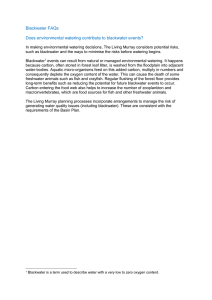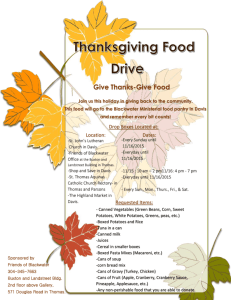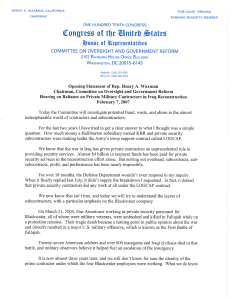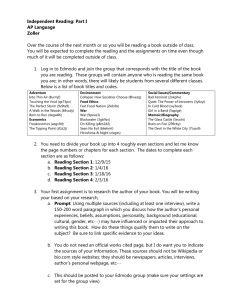Appendix 6.2 Blackwater River cSAC (Cork/Waterford) – Site Synopsis
advertisement
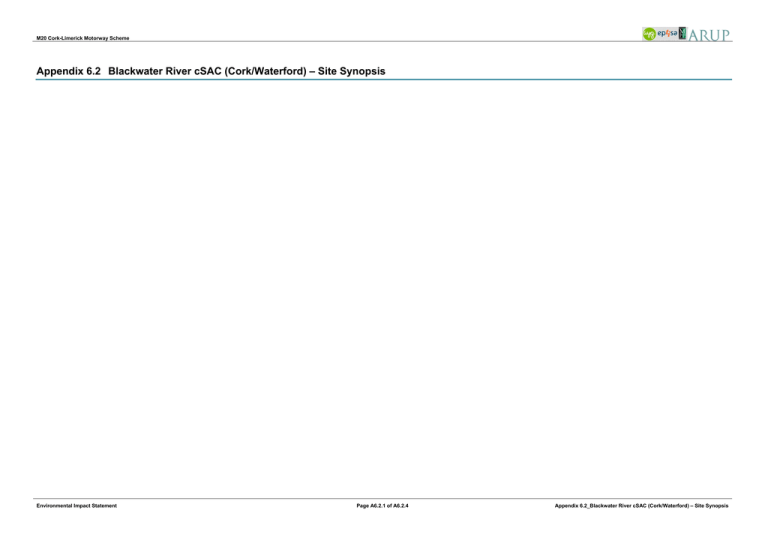
M20 Cork-Limerick Motorway Scheme Appendix 6.2 Blackwater River cSAC (Cork/Waterford) – Site Synopsis Environmental Impact Statement Page A6.2.1 of A6.2.4 Appendix 6.2_Blackwater River cSAC (Cork/Waterford) – Site Synopsis M20 Cork - Limerick Motorway Scheme APPENDIX 6.2 BLACKWATER RIVER cSAC (CORK/WATERFORD) - SITE CODE: 002170 - SITE SYNOPSIS The River Blackwater is one of the largest rivers in Ireland, draining a major part of Co. Cork and five ranges of mountains. In times of heavy rainfall the levels can fluctuate widely by more than 12 feet on the gauge at Careysville. The peaty nature of the terrain in the upper reaches and of some of the tributaries gives the water a pronounced dark colour. The site consists of the freshwater stretches of the River Blackwater as far upstream as Ballydesmond, the tidal stretches as far as Youghal Harbour and many tributaries, the larger of which includes the Licky, Bride, Flesk, Chimneyfield, Finisk, Araglin, Awbeg Buttevant), Clyda, Glen, Allow, Dalua, Brogeen, Rathcool, Finnow, Owentaraglin and Awnaskirtaun. The extent of the Blackwater and its tributaries in this site, flows through the counties of Kerry, Cork, Limerick, Tipperary and Waterford. Towns along, but not in the site, include Rathmore, Millstreet, Kanturk, Banteer, Mallow, Buttevant, Doneraile, Castletownroche, Fermoy, Ballyduff, Rathcormac, Tallow, Lismore, Cappoquin and Youghal. The Blackwater rises in boggy land of east Kerry , where Namurian grits and shales build the low heather-covered plateaux. Near Kanturk the plateaux enclose a basin of productive Coal Measures. On leaving the Namurian rocks the Blackwater turns eastwards along the northern slopes of the Boggeraghs before entering the narrow limestone strike vale at Mallow. The valley deepens as first the Nagles Mountains and then the Knockmealdowns impinge upon it. Interesting geological features along this stretch of the Blackwater Valley include limestone cliffs and caves near the villages and small towns of Killavullen and Ballyhooly; the Killavullen caves contain fossil material from the end of the glacial period. The associated basic soils in this area support the growth of plant communities which are rare in Cork because in general the county’s rocks are acidic. At Cappoquin the river suddenly turns south and cuts through high ridges of Old Red Sandstone. The Araglin valley is predominantly underlain by sandstone, with limestone occurring in the lower reaches near Fermoy. The site is a candidate SAC selected for alluvial wet woodlands and Yew wood, both priority habitats listed on Annex I of the E.U. Habitats Directive. The site is also selected as a candidate SAC for floating river vegetation, estuaries, tidal mudflats, Salicornia mudflats, Atlantic salt meadows, Mediterranean salt meadows, perennial vegetation of stony banks and old Oak woodlands, all habitats listed on Annex I of the E.U. Habitats Directive. The site is also selected for the following species listed on Annex II of the same directive - Sea Lamprey, River Lamprey, Brook Lamprey, Freshwater Pearl Mussel, Crayfish, Twaite Shad, Atlantic Salmon, Otter and the plant, Killarney Fern. Wet woodlands are found where river embankments, particularly on the River Bride, have broken down and where the channel edges in the steep-sided valley between Cappoquin and Youghal are subject to daily inundation. The river side of the embankments was often used for willow growing in the past (most recently at Cappoquin) so that the channel is lined by narrow woods of White and Almond-leaved Willow (Salix alba and S. triandra) with isolated Crack Willow (S. fragilis) and Osier (S. viminalis). Grey Willow (S. cinerea) spreads naturally into the sites and occasionally, as at Villierstown on the Blackwater and Sapperton on the Bride, forms woods with a distinctive mix of woodland and marsh plants, including Gypsywort (Lycopus europaeus), Guelder Rose (Viburnum opulus), Bittersweet (Solanum dulcamara) and various mosses and algae. These wet woodlands form one of the most extensive tracts of the wet woodland habitat in the country. A small stand of Yew (Taxus baccata) woodland, a rare habitat in Ireland and the EU, occurs within the site. This is on a limestone ridge at Dromana, near Villierstown. While there are some patches of the wood with a canopy of Yew and some very old trees, the quality is generally poor due to the dominance of non-native and invasive species such as Sycamore, Beech and Douglas Fir (Pseudotsuga menzsisii). However, the future prospect for this Yew wood is good as the site is proposed for restoration under a Coillte EU Life Programme. Owing to its rarity, Yew woodland is listed with priority status on Annex I of the EU Habitats Directive. Marshes and reedbeds cover most of the flat areas beside the rivers and often occur in mosaic with the wet woodland. Common Reed (Phragmites australis) is ubiquitous and is harvested for thatching. There is also much Marsh Marigold (Caltha palustris) and, at the edges of the reeds, the Greater and Lesser Pond-sedge (Carex riparia and C. acutiformis). Hemlock Water-dropwort (Oenanthe crocata), Wild Angelica (Angelica sylvestris), Reed Canary-grass (Phalaris arundinacea), Meadowsweet (Filipendula ulmaria), Nettle (Urtica dioica), Purple Loosestrife (Lythrum salicaria), Marsh Valerian (Valeriana officinalis), Water Mint (Mentha aquatica) and Water Forget-me-not (Myosotis scorpioides). At Banteer there are a number of hollows in the sediments of the floodplain Environmental Impact Statement where subsidence and subterranean drainage have created isolated wetlands, sunk below the level of the surrounding fields. The water rises and falls in these holes depending on the watertable and several different communities have developed on the acidic or neutral sediments. Many of the ponds are ringed about with Grey Willows, rooted in the mineral soils but sometimes collapsed into the water. Beneath the densest stands are woodland herbs like Yellow Pimpernel (Lysimachia nemorum) with locally abundant Starwort (Callitriche stagnalis) and Marsh Ragwort (Senecio palustris). One of the depressions has Silver Birch (Betula pendula), Ash (Fraxinus excelsior), Crab Apple (Malus sylvestris) and a little Oak (Quercus robur) in addition to the willows. Floating river vegetation is found along much of the freshwater stretches within the site. The species list is quite extensive and includes Pond Water-crowfoot (Ranunculus peltatus), Water-crowfoot (Ranunculus spp.), Canadian Pondweed (Elodea canadensis), Broad-leaved Pondweed (Potamogeton natans), Pondweed (Potamogeton spp.), Water Milfoil (Myriophyllum spp.), Common Club-rush (Scirpus lacustris), Water-starwort (Callitriche spp.), Lesser Water-parsnip (Berula erecta) particularly on the Awbeg, Water-cress (Nasturtium officinale), Hemlock Waterdropwort, Fine-leaved Water-dropwort (O. aquatica), Common Duckweed (Lemna minor), Yellow Water-lily (Nuphar lutea), Unbranched Bur-reed (Sparganium emersum) and the moss Fontinalis antipyretica. The grassland adjacent to the rivers of the site is generally heavily improved, although liable to flooding in many places. However, fields of more species-rich wet grassland with species such as Yellow-flag (Iris pseudacorus), Meadowsweet, Meadow Buttercup (Ranunculus acris) and rushes (Juncus spp.) occur occasionally. Extensive fields of wet grassland also occur at Annagh Bog on the Awbeg. These fields are dominated by Tufted Hair-grass (Deschampsia cespitosa) and rushes. The Blackwater Valley has a number of dry woodlands; these have mostly been managed by the estates in which they occur, frequently with the introduction of Beech (Fagus sylvatica) and a few conifers, and sometimes of Rhododendron (Rhododendron ponticum) and laurel. Oak woodland is well developed on sandstone about Ballinatray, with the acid Oak woodland community of Holly (Ilex aquifolium), Bilberry (Vaccinium myrtillus), Greater Woodrush (Luzula sylvatica) and Buckler Ferns (Dryopteris affinis, D. aemula) occurring in one place. Irish Spurge (Euphorbia hyberna) continues eastwards on acid rocks from its headquarters to the west but there are many plants of richer soils, for example Wood Violet (Viola reichenbachiana), Goldilocks (Ranunculus auricomus), Broad-leaved Helleborine (Epipactis helleborine) and Red Campion (Silene dioica). Oak woodland is also found in Rincrew, Carrigane, Glendine, Newport and Dromana. The spread of Rhododendron is locally a problem, as is over-grazing. A few limestone rocks stand over the river in places showing traces of a less acidic woodland type with Ash, False Brome (Brachypodium sylvaticum) and Early-purple Orchid (Orchis mascula). In the vicinity of Lismore, two deep valleys cut in Old Red Sandstone join to form the Owenashad River before flowing into the Blackwater at Lismore. These valleys retain something close to their original cover of Oak with Downy Birch (Betula pubescens), Holly and Hazel (Corylus avellana) also occurring. There has been much planting of Beech (as well as some of coniferous species) among the Oak on the shallower slopes and here both Rhododendron and Cherry Laurel (Prunus laurocerasus) have invaded the woodland. The Oak wood community in the Lismore and Glenmore valleys is of the classical upland type, in which some Rowan (Sorbus aucuparia) and Downy Birch occur. Honeysuckle (Lonicera periclymenum) and Ivy (Hedera helix) cover many of the trees while Greater Woodrush, Bluebell (Hyacinthoides non-scripta), Wood Sorrel (Oxalis acetosella) and, locally, Bilberry dominate the ground flora. Ferns present on the site include Hard Fern (Blechnum spicant), Male Fern (Dryopteris filix-mas), Buckler Ferns (D. dilatata, D. aemula) and Lady Fern (Athyrium felix-femina). There are many mosses present and large species such as Rhytidiadelphus spp., Polytrichum formosum, Mnium hornum and Dicranum spp. are noticeable. The lichen flora is important and includes 'old forest' species which imply a continuity of woodland here since ancient times. Tree Lungwort (Lobaria spp.) is the most conspicuous and is widespread. The Araglin valley consists predominantly of broadleaved woodland. Oak and Beech are joined by Hazel, Wild Cherry (Prunus avium) and Goat Willow (Salix caprea). The ground flora is relatively rich with Pignut (Conopodium majus), Wild Garlic (Allium ursinum), Garlic Mustard (Alliaria petiolata) and Wild Strawberry (Fragaria vesca). The presence of Ivy Broomrape (Orobanche hederae), a local species within Ireland, suggests that the woodland, along with its attendant Ivy is long established. Along the lower reaches of the Awbeg River, the valley sides are generally cloaked with mixed deciduous woodland of estate origin. The dominant species is Beech, although a range of other species are also present, e.g. Sycamore (Acer pseudoplatanus), Ash and Horse-chestnut (Aesculus hippocastanum). In places the alien invasive species, Cherry Laurel, dominates the understorey. Parts Page A6.2.2 of A6.2.4 Appendix 6.2_Blackwater River cSAC (Cork/Waterford) – Site Synopsis M20 Cork - Limerick Motorway Scheme of the woodlands are more semi-natural in composition, being dominated by Ash with Hawthorn (Crataegus monogyna) and Spindle (Euonymus europaea) also present. However, the most natural areas of woodland appear to be the wet areas dominated by Alder and willows (Salix spp.). The ground flora of the dry woodland areas features species such as Pignut, Wood Avens (Geum urbanum), Ivy and Soft Shield-fern (Polystichum setiferum), while the ground flora of the wet woodland areas contains characteristic species such as Remote Sedge (Carex remota) and Opposite-leaved Golden-saxifrage (Chrysosplenium oppositifolium). In places along the upper Bride, scrubby, semi-natural deciduous woodland of Willow, Oak and Rowan occurs with abundant Great Woodrush in the ground flora. The Bunaglanna River passes down a very steep valley, flowing in a north-south direction to meet the Bride River. It flows through blanket bog to heath and then scattered woodland. The higher levels of moisture here enable a vigorous moss and fern community to flourish, along with a well-developed epiphyte community on the tree trunks and branches. At Banteer a type of wetland occurs near the railway line which offers a complete contrast to the others. Old turf banks are colonised by Royal Fern (Osmunda regalis) and Eared Willow (Salix aurita) and between them there is a sheet of Bottle Sedge (Carex rostrata), Marsh Cinquefoil (Potentilla palustris), Bogbean (Menyanthes trifoliata), Marsh St. John's-wort (Hypericum elodes) and the mosses Sphagnum auriculatum and Aulacomnium palustre. The cover is a scraw with characteristic species like Marsh Willowherb (Epilobium palustre) and Marsh Orchid (Dactylorhiza incarnata). The soil high up the Lismore valleys and in rocky places is poor in nutrients but it becomes richer where streams enter and also along the valley bottoms. In such sites Wood Speedwell (Veronica montana), Wood Anemone (Anemone nemorosa), Enchanter's Nightshade (Circaea lutetiana), Barren Strawberry (Potentilla sterilis) and Shield Fern occur. There is some Wild Garlic, Three-nerved Sandwort (Moehringia trinervia) and Early-purple Orchid (Orchis mascula) locally, with Opposite-leaved Golden-saxifrage, Meadowsweet and Bugle in wet places. A Hazel stand at the base of the Glenakeeffe valley shows this community well. The area has been subject to much tree felling in the recent past and re-sprouting stumps have given rise to areas of bushy Hazel, Holly, Rusty Willow (Salix cinerea subsp. oleifoila) and Downy Birch. The ground in the clearings is heathy with Heather (Calluna vulgaris), Slender St John's-wort (Hypericum pulchrum) and the occasional Broom (Cytisus scoparius) occurring. The estuary and the other Habitats Directive Annex I habitats within it form a large component of the site. Very extensive areas of intertidal flats, comprised of substrates ranging from fine, silty mud to coarse sand with pebbles/stones are present. The main expanses occur at the southern end of the site with the best examples at Kinsalebeg in Co. Waterford and between Youghal and the main bridge north of it across the river in Co. Cork. Other areas occur along the tributaries of the Licky in east Co. Waterford and Glendine, Newport, Bride and Killahaly Rivers in Waterford west of the Blackwater and large tracts along the Tourig River in Co. Cork. There are narrow bands of intertidal flats along the main river as far north as Camphire Island. Patches of green algae (filamentous, Ulva species and Enteromorpha sp.) occur in places, while fucoid algae are common on the more stony flats even as high upstream as Glenassy or Coneen. The area of saltmarsh within the site is small. The best examples occur at the mouths of the tributaries and in the townlands of Foxhole and Blackbog. Those found are generally characteristic of Atlantic salt meadows. The species list at Foxhole consists of Common Saltmarsh-grass (Puccinellia maritima), small amounts of Greater Seaspurrey (Spergularia media), Glasswort (Salicornia sp.), Sea Arrowgrass (Triglochin maritima), Annual Seablite (Suaeda maritima) and Sea Purslane (Halimione portulacoides) - the latter a very recent coloniser - at the edges. Some Sea Aster (Aster tripolium) occurs, generally with Creeping Bent (Agrostis stolonifera). Sea Couchgrass (Elymus pycnanthus) and small isolated clumps of Sea Club-rush (Scirpus maritimus) are also seen. On the Tourig River additional saltmarsh species found include Lavender (Limoniun spp.), Sea Thrift (Armeria maritima), Red Fescue (Festuca rubra), Common Scurvy-grass (Cochlearia officinalis) and Sea Plantain (Plantago maritima). Oraches (Atriplex spp.) are found on channel edges. The shingle spit at Ferrypoint supports a good example of perennial vegetation of stony banks. The spit is composed of small stones and cobbles and has a well developed and diverse flora. At the lowest part, Sea Beet (Beta vulgaris), Curled Dock (Rumex crispus) and Yellow-horned Poppy (Glaucium flavum) occur with at a slightly higher level Sea Mayweed (Tripleurospermum maritimum), Cleavers (Galium aparine), Rock Samphire (Crithmum maritimum), Sandwort (Honkenya peploides), Spear-leaved Orache (Atriplex prostrata) and Babington’s Orache (A. glabriuscula). Other species present include Sea Rocket (Cakile maritima), Herb Robert (Geranium robertianum), Red Fescue (Festuca rubra) and Kidney Vetch (Anthyllis vulneraria). The top of the spit is more vegetated and includes lichens and bryophytes (including Tortula ruraliformis and Rhytidiadelphus squarrosus). The site supports several Red Data Book plant species, i.e. Environmental Impact Statement Starved Wood Sedge (Carex depauperata), Killarney Fern (Trichomanes speciosum), Pennyroyal (Mentha pulegium), Bird’s-nest Orchid (Neottia nidus-avis, Golden Dock (Rumex maritimus) and Bird Cherry (Prunus padus). The first three of these are also protected under the Flora (Protection) Order 1999. The following plants, relatively rare nationally, are also found within the site: Toothwort (Lathraea squamaria) associated with woodlands on the Awbeg and Blackwater; Summer Snowflake (Leucojum aestivum) and Flowering Rush (Butomus umbellatus) on the Blackwater; Common Calamint (Calamintha ascendens), Red Campion (Silene dioica), Sand Leek (Allium scorodoprasum) and Wood Club-rush (Scirpus sylvaticus) on the Awbeg. The site is also important for the presence of several Habitats Directive Annex II animal species, including Sea Lamprey (Petromyzon marinus), Brook Lamprey (Lampetra planeri), River Lamprey (L. fluviatilis), Twaite Shad (Alosa fallax fallax), Freshwater Pearl-mussel (Margaritifera margaritifera), Otter (Lutra lutra) and Salmon (Salmo salar). The Awbeg supports a population of White-clawed Crayfish (Austropotamobius pallipes). This threatened species has been recorded from a number of locations and its remains are also frequently found in Otter spraints, particularly in the lower reaches of the river. The freshwater stretches of the Blackwater and Bride Rivers are designated salmonid rivers. The Blackwater is noted for its enormous run of salmon over the years. The river is characterised by mighty pools, lovely streams, glides and generally, a good push of water coming through except in very low water. Spring salmon fishing can be carried out as far upstream as Fermoy and is very highly regarded especially at Careysville. The Bride, main Blackwater upstream of Fermoy and some of the tributaries are more associated with grilse fishing. The site supports many of the mammal species occurring in Ireland. Those which are listed in the Irish Red Data Book include Pine Marten, Badger and Irish Hare. The bat species Natterer’s Bat, Daubenton’s Bat, Whiskered Bat, Brown Long-eared Bat and Pipistrelle, are to be seen feeding along the river, roosting under the old bridges and in old buildings. Common Frog, a Red Data Book species that is also legally protected (Wildlife Act, 1976), occurs throughout the site. The rare bush cricket, Metrioptera roselii (Orthoptera: Tettigoniidae), has been recorded in the reed/willow vegetation of the river embankment on the Lower Blackwater River. The Swan Mussel (Anodonta cygnea), a scarce species nationally, occurs at a few sites along the freshwater stretches of the Blackwater. Several bird species listed on Annex I of the E.U. Birds Directive are found on the site. Some use it as a staging area, others are vagrants, while others use it more regularly. Internationally important numbers of Whooper Swan (average peak 174, 1994/95- 95/96) and nationally important numbers Bewick's Swan (average peak 35, 1994/9595/96) use the Blackwater Callows. Golden Plover occur in regionally important numbers on the Blackwater Estuary (average peak 885, 1984/85-86/87) and on the River Bride (absolute max. 2141, 1994/95). Staging Terns visit the site annually (Sandwich Tern (>300) and Arctic/Common Tern (>200), average peak 1974-1994). The site also supports populations of the following: Red Throated Diver, Great Northern Diver, Barnacle Goose, Ruff, Wood Sandpiper and Greenland White-fronted Goose. Three breeding territories for Peregrine Falcon are known along the Blackwater Valley. This, the Awbeg and the Bride River are also thought to support at least 30 pairs of Kingfisher. Little Egret now breed at the site (12 pairs in 1997, 19 pairs in 1998) and this represents about 90% of the breeding population in Ireland. The site holds important numbers of wintering waterfowl. Both the Blackwater Callows and the Blackwater Estuary Special Protection Areas (SPAs) hold internationally important numbers of Black-tailed Godwit (average peak 847, 1994/95- 95/96 on the callows, average peak 845, 1974/75-93/94 in the estuary). The Blackwater Callows also hold Wigeon (average peak 2752), Teal (average peak 1316), Mallard (average peak 427), Shoveler (average peak 28), Lapwing (average peak 880), Curlew (average peak 416) and Black-headed Gull (average peak 396) (counts from 1994/95-95/96). Numbers of birds using the Blackwater Estuary, given as the mean of the highest monthly maxima over 20 years (1974-94), are Shelduck (137 +10 breeding pairs), Wigeon (780), Teal (280), Mallard (320 + 10 breeding pairs), Goldeneye (11- 97), Oystercatcher (340), Ringed Plover (50 + 4 breeding pairs), Grey Plover (36), Lapwing (1680), Knot (150), Dunlin (2293), Snipe (272), Black-tailed Godwit (845), Bar-tailed Godwit (130), Curlew (920), Redshank (340), Turnstone (130), Blackheaded Gull (4000) and Lesser Black-backed Gull (172). The greatest numbers (75%) of the wintering waterfowl of the estuary are located in the Kinsalebeg area on the east of the estuary in Co. Waterford. The remainder are concentrated along the Tourig Estuary on the Co. Cork side. The river and river margins also support many Heron, non-breeding Cormorant and Mute Swan (average peak 53, 1994/95-95/96 in the Blackwater Callows). Heron occurs all along the Bride and Blackwater Rivers - 2 or 3 pairs at Dromana Rock; c. 25 pairs in the woodland opposite; 8 pairs at Ardsallagh Wood and c. 20 pairs at Rincrew Wood have been recorded. Some of these are quite large and significant heronries. Significant numbers of Cormorant are found north of the bridge at Youghal and there are some important roosts present at Ardsallagh Wood, Page A6.2.3 of A6.2.4 Appendix 6.2_Blackwater River cSAC (Cork/Waterford) – Site Synopsis M20 Cork - Limerick Motorway Scheme downstream of Strancally Castle and at the mouth of the Newport River. Of note are the high numbers of wintering Pochard (e.g. 275 individuals in 1997) found at Ballyhay quarry on the Awbeg, the best site for Pochard in County Cork. Other important species found within the site include Long-eared Owl, which occurs all along the Blackwater River, and Barn Owl, a Red Data Book species, which is found in some old buildings and in Castlehyde west of Fermoy. Reed Warbler, a scarce breeding species in Ireland, was found for the first time in the site in 1998 at two locations. It is not known whether or not this species breeds on the site, although it is known to nearby to the south of Youghal. Dipper occurs on the rivers. Landuse at the site is mainly centred on agricultural activities. The banks of much of the site and the callows, which extend almost from Fermoy to Cappoquin, are dominated by improved grasslands which are drained and heavily fertilised. These areas are grazed and used for silage production. Slurry is spread over much of this area. Arable crops are grown. The spreading of slurry and fertiliser poses a threat to the water quality of this salmonid river and to the populations of Habitats Directive Annex II animal species within it. Many of the woodlands along the rivers belong to old estates and support many non-native species. Little active woodland management occurs. Fishing is a main tourist attraction along stretches of the Blackwater and its tributaries and there are a number of Angler Associations, some with a number of beats. Fishing stands and styles have been erected in places. Both commercial and leisure fishing takes place on the rivers. Other recreational activities such as boating, golfing and walking are also popular. Water skiing is carried out at Villierstown. Parts of Doneraile Park and Anne’s Grove are included in the site: both areas are primarily managed for amenity purposes. There is some hunting of game birds and Mink within the site. Ballyhay quarry is still actively quarried for sand and gravel. Several industrial developments, which discharge into the river, border the site. The main threats to the site and current damaging activities include high inputs of nutrients into the river system from agricultural run-off and several sewage plants, dredging of the upper reaches of the Awbeg, overgrazing within the woodland areas, and invasion by nonnative species, for example Cherry Laurel. Overall, the River Blackwater is of considerable conservation significance for the occurrence of good examples of habitats and of populations of plant and animal species that are listed on Annexes I and II of the E.U. Habitats Directive respectively; furthermore it is of high conservation value for the populations of bird species that use it. Two Special Protection Areas, designated under the E.U. Birds Directive, are also located within the site Blackwater Callows and Blackwater Estuary. Additionally, the importance of the site is enhanced by the presence of a suite of uncommon plant species. Environmental Impact Statement Page A6.2.4 of A6.2.4 Appendix 6.2_Blackwater River cSAC (Cork/Waterford) – Site Synopsis
